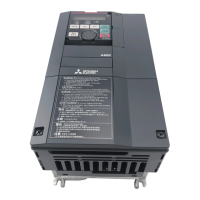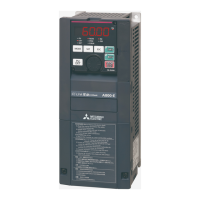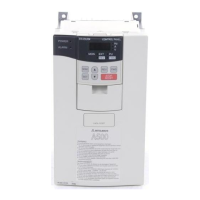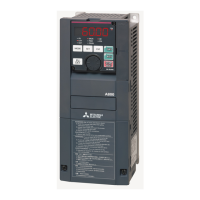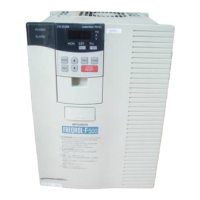399
Causes and corrective actions
5
PROTECTIVE FUNCTIONS
*1 When ND is selected. (Refer to page 426.)
*2 Resetting the inverter initializes the internal thermal integrated data of the electronic thermal relay function.
Operation Panel
Indication
E.OV1
FR-PU04
FR-PU07
OV During Acc
Name
Regenerative overvoltage shut-off during acceleration
Description
If regenerative energy causes the inverter's internal main circuit DC voltage to reach or exceed the
specified value, the protective circuit is activated to stop the inverter output. The circuit may also be
activated by a surge voltage produced in the power supply system.
Check point Check for too slow acceleration. (e.g. during descending acceleration in vertical lift load)
Corrective action
· Decrease the acceleration time.
· Use regeneration avoidance function (Pr. 882 to Pr. 886). (Refer to page 371.)
Operation Panel
Indication
E.OV2
FR-PU04
FR-PU07
Stedy Spd OV
Name
Regenerative overvoltage shut-off during constant speed
Description
If regenerative energy causes the inverter's internal main circuit DC voltage to reach or exceed the
specified value, the protective circuit is activated to stop the inverter output. The circuit may also be
activated by a surge voltage produced in the power supply system.
Check point
Check for sudden load change.
Corrective action
· Keep load stable.
· Use regeneration avoidance function (Pr. 882 to Pr. 886). (Refer to page 371.)
· Use the brake unit or power regeneration common converter (FR-CV) as required.
Operation Panel
Indication
E.OV3
FR-PU04
FR-PU07
OV During Dec
Name
Regenerative overvoltage shut-off during deceleration or stop
Description
If regenerative energy causes the inverter's internal main circuit DC voltage to reach or exceed the
specified value, the protective circuit is activated to stop the inverter output. The circuit may also be
activated by a surge voltage produced in the power supply system.
Check point
Check for sudden speed reduction.
Corrective action
· Increase the deceleration time. (Set the deceleration time which matches the inertia of moment of
the load)
· Decrease the braking duty.
· Use regeneration avoidance function (Pr. 882 to Pr. 886). (Refer to page 371.)
· Use the brake unit or power regeneration common converter (FR-CV) as required.
Operation Panel
Indication
E.THT
FR-PU04
FR-PU07
Inv. Overload
Name
Inverter overload shut-off (electronic thermal relay function) *2
Description
If a current not less than 150% of the rated output current flows and overcurrent shut-off does not occur
(220% or less), inverse-time characteristics cause the electronic thermal relay to be activated to stop
the inverter output in order to protect the output transistors. (overload immunity 150%*1 60s)
Check point
Check the motor for use under overload.
Corrective action
Reduce the load weight.
Operation Panel
Indication
E.THM
FR-PU04
FR-PU07
Motor Overload
Name
Motor overload shut-off (electronic thermal relay function) *2
Description
The electronic thermal relay function in the inverter detects motor overheat due to overload or reduced
cooling capability during constant-speed operation and pre-alarm (TH display) is output when the
temperature reaches 85% of the Pr. 9 Electronic thermal O/L relay setting and the protection circuit is
activated to stop the inverter output when the temperature reaches the specified value. When running
a special motor such as a multi-pole motor or multiple motors, provide a thermal relay on the inverter
output side since such motor(s) cannot be protected by the electronic thermal relay function.
Check point
1. Check the motor for use under overload.
2. Check that the setting of Pr. 71 Applied motor for motor selection is correct. (Refer to page 179.)
3. Check that stall prevention operation setting is correct.
Corrective action
1. Reduce the load weight.
2. For a constant-torque motor, set the constant-torque motor in Pr. 71 Applied motor.
3. Check that stall prevention operation setting is correct. (Refer to page 144.)
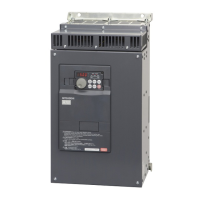
